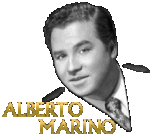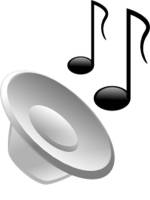Alberto Marino – 1923
Alberto Marino (April 26, 1923 – June 21, 1989)

As a friend of mine used to say “Alberto Marino is a privilege for tango”. This exaggeration originated, surely, in his tenor range and the influence of the Italian school of bel canto, even though it was felt by several tango vocalists, in Tano Marino’s case, it generated the impression that his voice was much more than what was needed for the challenge of the lyrics. He switched from a powerful high note to a deep bass with the facility of the blessed, he had an unmistakable vibrato but he used it with discretion.His enemies, even though they recognized his capacity, criticized him saying that he was cold and lacking in mezza voce. What is true is that the great orchestra leader Alfredo Gobbi named him “La voz de oro del tango”(the golden voice of tango).
He made his debut as orchesta singer in 1939 singing in Emilio Balcarce’s orchestra with the nickname Alberto Demari. When Emilio Orlando took over the leadership of that orchestra, the singer changed his artistic name and adopted the one that finally would remain throughout his career: Alberto Marino.
The bandoneonist Aníbal Troilo heard him sing and suggested the latter to join the former’s outfit. Marino had already made an agreement to join the orchestra of Rodolfo Biagi, but accepted Troilo’s suggestion, and worked with him from 1943 until 1947.
For many people it was the singer’s best time, his renditions of the tangos “Tres amigos“, “Fuimos” and “Tal vez será su voz” are authentic jewels, among many others, of his contribution to the history of tango.
After that successful stage he decided to start his career as soloist. His first orchestra was conducted by the violinist Emilio Balcarce,the same one with whom he had begun in 1939. Later the bandoneonist Enrique Alessio took over the leadership of his orchestra and some time later he is replaced by the Uruguayan musician, Héctor María Artola. From that time we can highlight his recordings of the tangos “El motivo“, “Farolito de papel” (with the original lyrics, in lunfardo) and “Venganza” a Brazilian samba by Lupicínio Rodrigues arranged as a tango.
In the late 1949 he changed the accompaniment for the guitar ensemble of Roberto Grela, and recorded for the Odeon label. The singer and the guitarist would meet again around 1959, producing recordings out of this association.
In the fifties he went on his busy activity with various orchestras such as those of: Hugo Baralis, Osvaldo Manzi, Alfredo De Franco. In that decade as well he made numerous tours throughout Latin America and the United States with the outfits of Edelmiro D’Amario and César Zagnoli, among others.
In the sixties he is accompanied by José Canet‘s guitar ensemble and recorded 12 numbers. As a curiosity we can mention the rendition of the zamba “La López Pereyra” arranged as a tango. In the late sixties and during the seventies he kept on performing without interruption with first class orchestras such as those of Miguel Caló, Armando Pontier, Carlos García, Osvaldo Requena, Alberto Di Paulo, in most cases recording with them. He no longer had a tenor range, but in like manner he sang as a fine baritone.
He admired Gardel and Charlo, but when he was asked about who influenced on his expression and phrasing, he invariably answered: Antonio Rodríguez Lesende. A singer hardly known, whose recordings are very hard to find and that are around sixteen renditions. He recorded with the accompaniments of the important orchestras of Antonio Bonavena, Ricardo Luis Brignolo, Típica Brunswick, Carlos Di Sarli and Edgardo Donato.
Alberto Marino passed away all of a sudden, his voice was still strong, leaving in us, those who admire the glow and the sound of his golden voice, an unforgettable memory.
Article url: http://www.todotango.com/english/creadores/amarino.html

